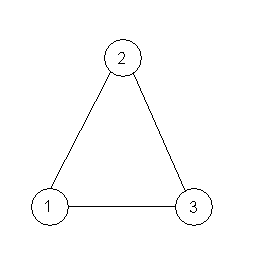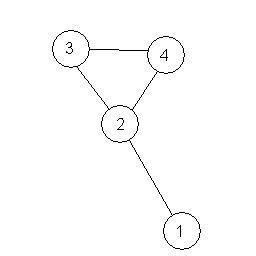Write a program that can be executed from the command line with
Match gmfile gdfile
for C++, or
java Match gmfile gdfile
for Java. The gmfile and gdfile arguments should be the names of two files that contain graphs (see the format specified below).
Details
Reading the Graphs
You will need to read the graphs from two files, one for each graph. The graphs are undirected, and the nodes are labeled between 1 and the number of nodes, which is specified in the file. The file format is as follows:
GRAPH NAME (a string) N (the number of nodes, an integer) M (the number of edges, an integer) U1 V1 (two node labels specifying an edge, both integers) U2 V2 U3 V3 . . . UM VM
For example, a graph file might look like:
|
||
|
or |
||
|
Output
Suppose the above two graphs are stored in files triangle.graph and kite.graph. Then, the command
Match triangle.graph kite.graph
should output
ISOMORPHISM: (1,2),(2,3),(3,4) ISOMORPHISM: (1,2),(2,4),(3,3) ISOMORPHISM: (1,3),(2,2),(3,4) ISOMORPHISM: (1,3),(2,4),(3,2) ISOMORPHISM: (1,4),(2,2),(3,3) ISOMORPHISM: (1,4),(2,3),(3,2)
If there are no isomorphisms, output NO ISOMORPHISMS on a separate line with no punctuation.
What To Turn In
You should turn in the following:
- a readme file describing what you did
- all of your code
- the output you get for each of the following invocations of your
program:
- Match small_house.graph big_house.graph (2 expected.)
- Match c4.graph small_house.graph (16 expected).
- Match k4.graph big_house.graph (0 expected).
For your own amusement, you can try
- Match k5.graph usa.graph
All of the above files are included in the graphs.zip archive. You can use the triangle and kite graphs to help debug your program.
And Remember.....
- Your java class which contains the main method must be named Match
- Your program must take in two input filenames in the same order as stated earlier in this document. You can refer to your earlier projects or the sample file given to you with this project to figure out: how command line arguments are passed.
- Please make sure you follow the output format as closely as possible.
Some sample outputs for your comparison
Comparing k5.graph to usa.graph gives thisComparing triangle.graph to k4.graph gives this
Comparing small_house.graph to usa.graph gives this

